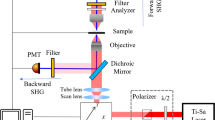Abstract:
We introduce the concept of repeatedly exciting an excited state of a photostable fluorescent entity to generate a nonlinear fluorescence signal which is solely based on the linear susceptibility of the molecule. The excitation cycle between the fluorescent state and another state prolongs the average lifetime of , with emphasis on those molecules that are in the center of the focus. The photons emitted by the long-lived molecules in the center are recorded by a temporal filter and constitute fluorescence that depends nonlinearly on the excitation intensity. Theoretical analysis reveals that this concept can provide three-dimensional imaging and improve the spatial resolution in far-field fluorescence microscopy. We show that despite the presence of diffraction the effective focal waist can in principle be narrowed down to the molecular scale at the expense of signal.
Similar content being viewed by others
Author information
Authors and Affiliations
Additional information
Received: 3 December 1998
Rights and permissions
About this article
Cite this article
Schönle, A., Hell, S. Far-field fluorescence microscopy with repetitive excitation. Eur. Phys. J. D 6, 283–290 (1999). https://doi.org/10.1007/s100530050310
Issue Date:
DOI: https://doi.org/10.1007/s100530050310




